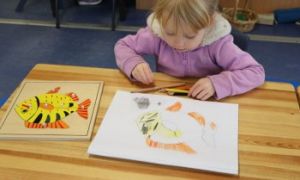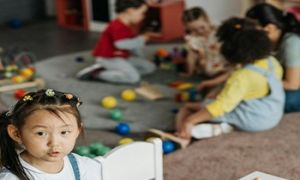Auditory learning is a crucial aspect of early childhood education, as it helps children develop language, listening, and communication skills. The following article provides information on How To Identify Auditory Learners, Characteristics of Auditory Learners, Strategies to Support Auditory Learners, and more.
How To Identify Auditory Learners
Identifying auditory learners involves observing how children prefer to receive and process information. Here are some characteristics and behaviors that can help you identify auditory learners in early childhood:
-
Strong Listening Skills
-
Behavior: They pay close attention to sounds and spoken instructions.
-
Example: Following oral directions accurately and remembering details from stories or songs.
-
-
Enjoys Talking and Listening
-
Behavior: They enjoy engaging in conversations and listening to others.
-
Example: Participating actively in group discussions and storytelling.
-
-
Learns Through Verbal Instructions
-
Behavior: They prefer listening to explanations rather than reading or looking at diagrams.
-
Example: Understanding tasks better when they are explained verbally rather than through written instructions.
-
-
Strong Recall of Auditory Information
-
Behavior: They remember information they have heard, such as facts, stories, and songs.
-
Example: Recalling details from a story read aloud or a song played in class.
-
-
Prefers Reading Aloud
-
Behavior: They enjoy reading aloud or listening to others read.
-
Example: Choosing to read books aloud to themselves or asking others to read to them.
-
-
Good at Following Oral Directions
-
Behavior: They can easily follow multi-step verbal instructions.
-
Example: Completing tasks accurately when given spoken directions.
-
-
Enjoys Music and Rhymes
-
Behavior: They have a strong interest in music, songs, and rhymes.
-
Example: Singing along to songs, remembering lyrics, and enjoying musical activities.
-
Strategies for Supporting Auditory Learners
-
Verbal Instructions and Explanations
-
Provide clear and detailed verbal instructions for tasks and activities.
-
Use storytelling to explain concepts and ideas.
-
-
Interactive Read-Alouds
-
Read books aloud and engage children in discussions about the story.
-
Encourage children to ask questions and share their thoughts.
-
-
Listening Activities
-
Incorporate listening games and activities, such as "Simon Says" and sound matching games.
-
Use audio books and recordings of stories, poems, and songs.
-
-
Music and Rhymes
-
Integrate music and singing into daily routines and lessons.
-
Use songs and rhymes to teach concepts and reinforce learning.
-
-
Group Discussions
-
Hold regular circle time discussions where children can listen and respond to each other.
-
Encourage children to share their ideas and experiences verbally.
-
-
Repetition and Reinforcement
-
Use repetition to reinforce key concepts and information.
-
Repeat instructions and important points to ensure understanding.
-
By recognizing and supporting auditory learners, you can create a more inclusive and effective learning environment that caters to their strengths and preferences.
Supporting Auditory Learners In Early Childhood
Supporting auditory learners in early childhood involves creating a rich, engaging environment that caters to their preference for hearing and verbal activities. Here are some strategies and activities to help support auditory learners:
1. Incorporate Music and Songs
-
Activity: Use songs and music to teach concepts and routines.
-
Example: Sing the alphabet song, counting rhymes, or cleanup songs to reinforce learning and routines.
2. Storytelling and Read-Alouds
-
Activity: Regularly read books and tell stories to children, using expressive voices and sound effects to make it engaging.
-
Example: Choose interactive storybooks that encourage children to participate by repeating phrases or making sound effects.
3. Listening Games
-
Activity: Play games that focus on listening skills and following directions.
-
Example: Games like “Simon Says” or “Musical Chairs” help children practice listening and responding to verbal instructions.
4. Audio Books and Recordings
-
Activity: Provide access to audio books and recordings of stories, poems, and songs.
-
Example: Use a listening center with headphones and a selection of audio books that children can listen to independently.
5. Rhyming and Phonemic Activities
-
Activity: Engage in activities that emphasize rhyming, phonemic awareness, and sound recognition.
-
Example: Play rhyming games, clap out syllables, and identify beginning sounds of words.
6. Circle Time Discussions
-
Activity: Hold regular circle time discussions where children listen and respond to each other.
-
Example: Discuss the day’s events, share stories, or talk about a specific theme, encouraging children to express their thoughts and listen to others.
7. Sound Exploration
-
Activity: Explore different sounds using various objects and materials.
-
Example: Create a sound exploration center with musical instruments, shakers, and everyday objects that make interesting sounds.
8. Interactive Read-Alouds
-
Activity: Engage children in interactive read-aloud sessions that encourage participation.
-
Example: Ask questions during the story, encourage children to predict what happens next, and discuss characters and plot.
9. Verbal Instructions and Explanations
-
Activity: Provide clear and detailed verbal instructions for tasks and activities.
-
Example: Explain activities step-by-step and check for understanding by asking children to repeat the instructions.
10. Role-Playing and Dramatization
-
Activity: Use role-playing and dramatization to reinforce learning and social skills.
-
Example: Act out stories, scenarios, or social situations, encouraging children to use language and listen to each other.
By incorporating these strategies and activities into your daily routine, you can create a supportive and engaging learning environment that caters to the needs of auditory learners.
Benefits of Auditory Learning
-
Language Development: Auditory learning enhances vocabulary, phonemic awareness, and the ability to understand and use language effectively.
-
Listening Skills: It helps children develop the ability to focus, follow directions, and understand spoken information.
-
Memory and Recall: Auditory activities improve memory and the ability to recall information.
-
Social Skills: Engaging in auditory learning activities promotes social interaction and effective communication.







 As an Educator in Australia, your pay rate falls under the Children’s Services Award 2010. This award states the minimum amount that an employer can
As an Educator in Australia, your pay rate falls under the Children’s Services Award 2010. This award states the minimum amount that an employer can When working as a qualified Early Childhood Teacher (with a university degree) within a service, your rate of pay will come from the Educational Services
When working as a qualified Early Childhood Teacher (with a university degree) within a service, your rate of pay will come from the Educational Services When working as a Diploma Qualified Educator your pay rate is from the Children's Services Award 2010. This Award states your minimum rate of pay
When working as a Diploma Qualified Educator your pay rate is from the Children's Services Award 2010. This Award states your minimum rate of pay When working as a Cert 3 Qualified Educator, your pay rate is from the Children's Services Award 2010. This Award states your minimum rate of
When working as a Cert 3 Qualified Educator, your pay rate is from the Children's Services Award 2010. This Award states your minimum rate of Educational Leaders play a crucial role in their early childhood service by ensuring that the educational program aligns with best practices and supports the holistic
Educational Leaders play a crucial role in their early childhood service by ensuring that the educational program aligns with best practices and supports the holistic In early childhood education and care, ratios are more than a technicality—they are a frontline safeguard. Every child deserves responsive supervision, emotional connection, and developmental
In early childhood education and care, ratios are more than a technicality—they are a frontline safeguard. Every child deserves responsive supervision, emotional connection, and developmental Here’s a comprehensive Mobile Phone and Smart Watch Policy tailored for early childhood education and care (ECEC) services in Australia, aligned with the latest 2025
Here’s a comprehensive Mobile Phone and Smart Watch Policy tailored for early childhood education and care (ECEC) services in Australia, aligned with the latest 2025 With the new national child safety reforms kicking in on 1 September 2025, early childhood services like yours have a real opportunity to lead the
With the new national child safety reforms kicking in on 1 September 2025, early childhood services like yours have a real opportunity to lead the The Sea of Fish Challenge is a national initiative that invites children, educators, families, and communities to create and display fish artworks as a symbol
The Sea of Fish Challenge is a national initiative that invites children, educators, families, and communities to create and display fish artworks as a symbol Across the early childhood education and care sector, educators are sounding the alarm: current staffing ratios are insufficient to deliver safe, meaningful, and developmentally appropriate
Across the early childhood education and care sector, educators are sounding the alarm: current staffing ratios are insufficient to deliver safe, meaningful, and developmentally appropriate


